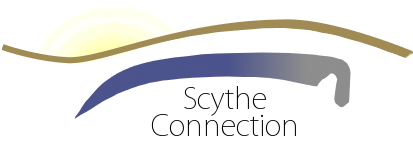 |
| Man with Scythe, Eastman Johnson, 1868 |
As a continuation of an earlier post with American Scythe Instructions, here are some additional sources of information, including discussion about young beginners.
The following Instructions to Young Mowers (from 1840) suggest that boys as young as fourteen can start with a "very light" scythe, for one or two hours per day during the haying seasons, over two or three years while they learn and improve. As stated in previous instructions, the blade should be kept near the ground, and horizontal, throughout the stroke. Also mentioned is how to check for the proper balance:
...Let his snath and scythe be very light, and the scythe of razor-like edge, and so hung that when suspended on the finger by the lower nib, the point and heel of the scythe may be at equal distances from the ground...
Instruct him to stand nearly erect, the hips being further advanced than the shoulders, and under no circumstances to stoop...
...and when inserting his scythe into the grass, be sure to keep the heel nigh the ground; and when cutting the clips and after, let the point be equally near it...
...let the body turn with the scythe as on a pivot the heel of the scythe passing within two or three inches of the advanced foot. This will relieve the arms, and so divide the effort, that he will mow with as little fatigue as he can perform light work, and soon laugh at the "six footer" who stoops to reach his...
...Let the boy also at first be instructed to clip only ten or twelve inches of grass until his erect posture and the horizontal position of his scythe become habitual...
-- quoted from The Farmer's Cabinet, Volume 4, No. 12, 1840, Philadelphia
Here's a different set of instructions which echo the admonition to swing the blade horizontally, level with the ground:
To mow with ease, the scythe should be swung gently, in a horizontal line, or parallel with the surface of the ground, entering the grass nearly on the right of the mower, and leaving it or cutting the last part nearly on the left; so that the standing grass in the swath will be nearly in a semicircular form.
-- quoted from New England Farmer, Vol. 2, No. 14, 1850, Boston
Another article in the New England Farmer states that beginners should not get inferior scythes:
The cast-off scythe should not be put into the hands of the boy who is learning to mow -- he wants in his feebler and and unpracticed hand, a sharper edge than is required by the man. Give him a good and a light tool; or else excuse him from this work.
-- quoted from New England Farmer, June 23, 1831, Boston
In closing, here's an article titled "Hay Time", in which the author recalls the first scythe he owned:
I remember the first scythe I ever had. I was about 16 and as puny a lad as you would wish to see. But I wanted a scythe. So I walked four miles to a store where they had a good assortment of them, and picked out one that I liked. It was but about three feet long, and I got a light snath to go with it, and then went to a grindstone that was turned by water, and got it ground. I then had it nicely hung so that it balanced just right, and got me a new rifle that exactly fitted my hand, and then I was a man, every inch of me.
I had learned how to whet a scythe, and I took especial care to keep it sharp. I soon got a knack of swinging it easily, without a great outlay of strength, for this I had not, so I made up for want of strength by sleight of hand.
-- quoted from New England Farmer, Vol. 8, No. 9, 1856, Boston
Sources:
Painting: Man with Scythe, by Eastman Johnson, 1868
"Instructions to Young Mowers" from The Farmer's Cabinet, Volume 4, No. 12, 1840, Philadelphia, page 371
"Grass-Scythes" from New England Farmer, Vol. 2, No. 14, 1850, Boston, page 219
"Hay Time" from New England Farmer, Vol. 8, No. 9, 1856, Boston, page 435










No comments:
Post a Comment